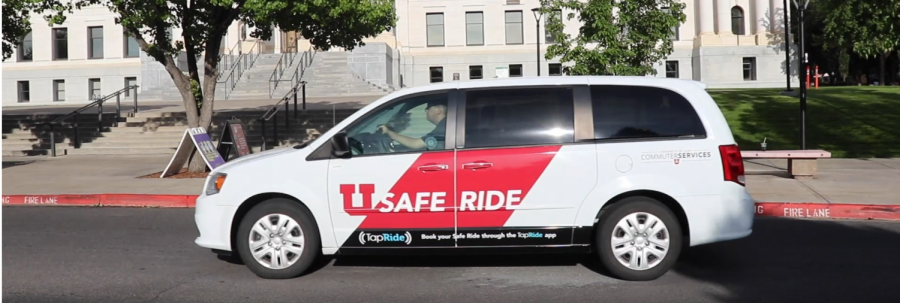SafeRide Started at the U Nearly a Month Ago. Is it Helping Students?
September 26, 2019
Tragic events in the past two years have raised some questions and concerns about whether or not the University of Utah takes its goal of a safe campus seriously. The new SafeRide shuttle is just one of the ways the U is trying to answer those concerns.
The SafeRide shuttle is a free transportation shuttle offered by Commuter Services for anyone who feels uncomfortable walking through campus at night. The shuttle uses an app called TapRide, which allows students to request a ride to and from anywhere on campus (except Research Park). The shuttle is driven by students, and runs from 6 p.m. to 12:30 a.m. Monday through Friday.
SafeRide is a new service offered by commuter services that started running the first day of school, Aug. 19. When asked how the launch has been, the Executive Director for Commuter Services, Alma Allred, said, “We are getting more people each week, we’re looking at expanding it and getting a couple of cars.”
There are two cars being used currently, but there is an ADA option for those who need it. “We are getting about five to fifteen calls a night,” Allred said. “Between 8 p.m. and 10 p.m. is when we get the most calls.” According to Allred, the “hotspots” on campus with the highest number of pickups and drop-offs are around the Marriott Library and the Peterson Heritage Center.
For a brand-new service with the usage continuing rise, does SafeRide have a long pick-up time? Not at all, Allred said. According to him, “about 7 minutes” is the average wait time.
Some students dispute Allred’s claim. Junior Abby Harper estimates that she waited about 3o minutes for the shuttle. However, Harper said this wait time “is shorter than waiting for a police officer to escort you. They take forever.”
Questions about how the student drivers are screened have been raised throughout campus. “The fact that [the drivers] are hired by the University [means] there is a vetting process,” Allred said. She also said that all drivers go through a background check.
Harper said she was comfortable with the driver of her SafeRide vehicle.
“I do think SafeRide is a good idea and will help prevent the horrific events that have been occurring on campus,” Harper said. “As a woman, I don’t feel comfortable walking around campus past dusk and that isn’t fair at all. The university is supposed to be a safe environment, and it is not.”
“I think it is awesome that the University is coming up with new ways to help out students who feel like they need help,” said Ezri Staheli, a junior at the U.
As mentioned previously, SafeRide only picks up and drops off students on campus, “One of the reasons we decided to limit it to campus is because a couple of other universities tried a similar system and they were able to forecast what it was going to cost them,” Allred said. “Those universities ended up spending over three million dollars…we don’t have three million dollars.”
Because SafeRide is meant for students and staff who feel unsafe walking on campus at night, Commuter Services put out a disclaimer on their SafeRide website that says “The Commuter Services’ SafeRide program is intended to be used by members of the university community who do not feel safe walking to a destination on campus at night. This is not a replacement for public transportation or other ride-share programs.” Commuter Services provides a FAQ section of its SafeRide website for students who would like more information.









Josh Petersen • Oct 29, 2019 at 3:46 pm
@Utah Student. Thank you for the note. We have corrected the article accordingly
Utah Student • Oct 29, 2019 at 12:51 pm
One note, Alma Allred is a male!
Christian • Oct 2, 2019 at 2:02 pm
I strongly believe SafeRide is actually worse now. For one thing, a minivan can’t handle the snow as well as a security pickup truck. Secondly, now it only goes until like 11:30pm? It used to go almost all night, and the service was much faster before than now. Good intentions, but degraded follow-through.